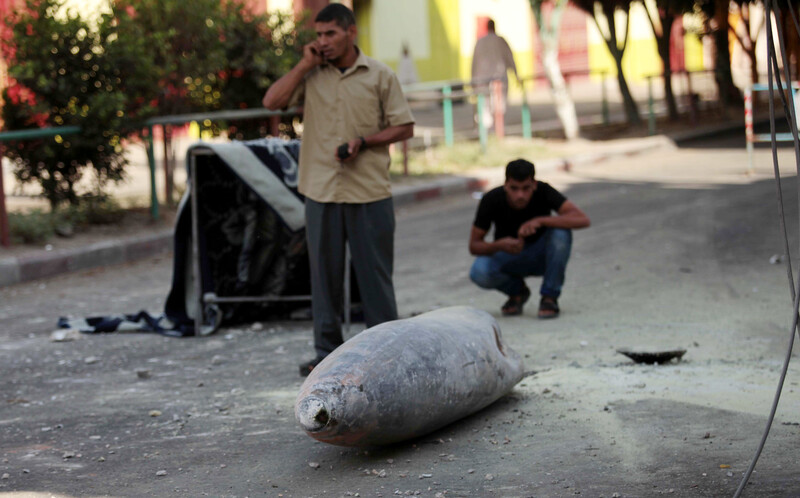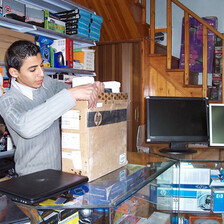The Electronic Intifada 30 January 2019

Many unexploded missiles were found in Gaza during — and after — Israel’s 2014 attack.
APA imagesWhere can you hide when you can’t run?
This is the question Gaza’s two million inhabitants ask themselves after every Israeli assault.
It was the question Abdallah Zaid, 45, last asked himself in November when a bombing raid came perilously close to his home in the Nasser neighborhood of Gaza City.
It was evening when a neighbor came and advised Abdallah and his family – spouse Naila and seven children – to evacuate their home. They feared that the building next door, home to the Hamas-affiliated al-Aqsa TV station, was going to be a target for Israeli missiles.
They were right. On 12 November, Israel launched an intense bombing campaign a day after a raid into Gaza – apparently an intelligence gathering mission – had gone dramatically wrong.
In total, Israeli missiles hit more than 70 targets over the next day or so, including residential buildings, a hotel and the TV station, before a new ceasefire was called on 13 November.
As usual, residents in targeted neighborhoods were sent scrambling for safety. And as always they wondered: where to go?
“I didn’t know where we were going,” Abdallah told The Electronic Intifada. “We were barefoot. What mattered was to be far away from any danger near the house.”
The problem, he pointed out, is that “there is no safe place in Gaza.” There are shelters – primarily UN schools, though people sometimes seek shelter in mosques too.
But these don’t seem safe and people have lost faith in them since 2014, Abdallah said, when even the “schools were threatened.”
During the 2014 Israeli war on Gaza, a number of UN schools were struck by Israeli missiles and bombs, leaving dozens dead, including UN staff.
A number of mosques met the same fate.
An impossible task
For Gaza’s authorities, trying to protect people is an impossible task.
Raed al-Dahshan, director of civil defense operations in Gaza, pointed to the lack of infrastructure to protect civilians.
“There is no safe place where Gazans can hide in case of bombings or war. There are no bunkers or buildings designed with bomb shelters,” al-Dahshan told The Electronic Intifada.
During the three Israeli wars on Gaza in the past decade, civil defense efforts have focused on conveying safety information to the public over the radio, directing them to take shelter away from windows, upper floors and balconies and seek out the strongest parts of their houses or buildings.
But information cannot combat a powerful army like Israel’s, which does not care about civilian casualties.
Al-Dahshan said this was clearly the case in 2014 in the Shujaiya area east of Gaza City which resulted in a massacre of at least 55 civilians in the area over less than two days.
Al-Dahshan was part of the rescue effort in the area at the time. He is convinced, he said, that the Israeli military knew exactly where people were but continued its assault anyway.
In the absence of safe spaces, some organizations are trying to prepare Palestinians in Gaza for how to act in the emergency situations they so often face.
One such program, designed by the Ma’an Development Center in partnership with UNMAS – the UN’s Mine Action Service – and Norwegian People’s Aid, was set up after the 2014 Israeli war on Gaza to deal with the unexploded remnants of war.
The project started with a publicity campaign to raise awareness of how to deal with unexploded ordnance.
Between 2014 and 2016, according to the UN, 17 people died and more than 100 were injured, including more than 45 children, as a result of not properly handling the unexploded remnants of Israel’s assault.
Preparing for war
Hani Abu Hatab, the Ma’an field coordinator for the program, said the project was created because no organization had taken such a step before and there was a desperate need.
More than 60,000 people have now taken the program, mostly in areas previously affected by Israeli assaults, Abu Hatab said.
The training is divided into two parts. The first concerns general preparations for war including identifying the safest spaces in people’s homes – away from main roads and as far as possible from windows – and taking precautions like stocking up on food and water and making sure to have access to first aid kits.
People are also taught what to do and not to do during an offensive – such as staying away from public buildings or security installations – as well as after – not returning to partially destroyed homes because these might still collapse.
The second part of Ma’an’s training involves practical skills.
People are taught first aid, how to fight or contain fires and how to deal with the injured. They are also told how to identify, handle or not handle unexploded remnants of war.
Ma’an has formed a group of emergency committees in local communities across Gaza. The idea is that a prominent member of the community will function as a liaison with Ma’an in order to help in times of emergency, whether by conveying information to the community, aiding local residents or helping lead rescue operations in the area, should they be necessary.
According to Abu Hatab, there are 186 such volunteers spread across all Gaza’s governorates.
Such public outreach is crucial in dealing with a population traumatized by war.
Frightened by the dark
Ahmed al-Saqa, 35, has come to hate the dark. Evenings and nights are when Israeli planes carry out attacks on Gaza.
Like almost everybody else in Gaza, al-Saqa therefore keeps a close eye on the news, always looking for escalation.
He wonders where to go if another war breaks out. His house in Khuzaa, in the eastern part of Khan Younis, was destroyed in the 2014 war.
With the house not yet rebuilt, al-Saqa has since been living in rented accomodation in the Sheikh Radwan neighborhood of Gaza City.
“Gaza is surrounded,” al-Saqa told The Electronic Intifada. “Egypt in the south, the occupation to the north and east. And to the west is the sea and the occupation’s navy. This is our situation. We will be in great danger in another war.”
He is not the only one to be scared of the night. Back in November, Rand Abu al-Attah, 4, woke up in the middle of the night, again, terrified of the explosions she could hear from outside.
These are sounds parents can’t guard against. Alaa, Rand’s mother, said all she can do when the planes start bombing is take her daughter to the safest place she can find in the house, away from windows and doors, and pray.
“We cannot forget the scenes of the three Israeli wars on Gaza,” Alaa, 29, told The Electronic Intifada. “In 2014, we had to escape to the street when our neighbor’s house was bombed. Now, my daughter is getting older and she knows the sound of bombings. It horrifies her.”
Abdallah Zaid, who in November had to take his family into the street because of their home’s proximity to Al-Aqsa TV station, said he had grown weary of international TV footage showing fearful Israelis taking cover in bunkers.
“No one sees us running barefoot in the street, heading for schools and mosques that will also be targeted,” he said.
And like every Palestinian in Gaza, he has his own very personal war story, the kind that dominates people’s memories of the last decade.
Yazan, his 9-year-old son, was born on 27 December 2008, when a major Israeli attack on Gaza began.
“This was supposed to be a happy day,” he said. “But while my wife was giving birth in al-Shifa hospital, I was watching all the dead bodies coming in. It was not a happy day. We don’t want any more war.”
Ola Mousa is an artist and writer from Gaza.





